December 20th marks our 6 month anniversary since leaving New York City and hitting the road! The time has flown. We’ve seen so much and yet it feels like we’ve barely scratched the surface of all there is to do. It’s hard to believe that we originally considered only spending 6 months on this trip.
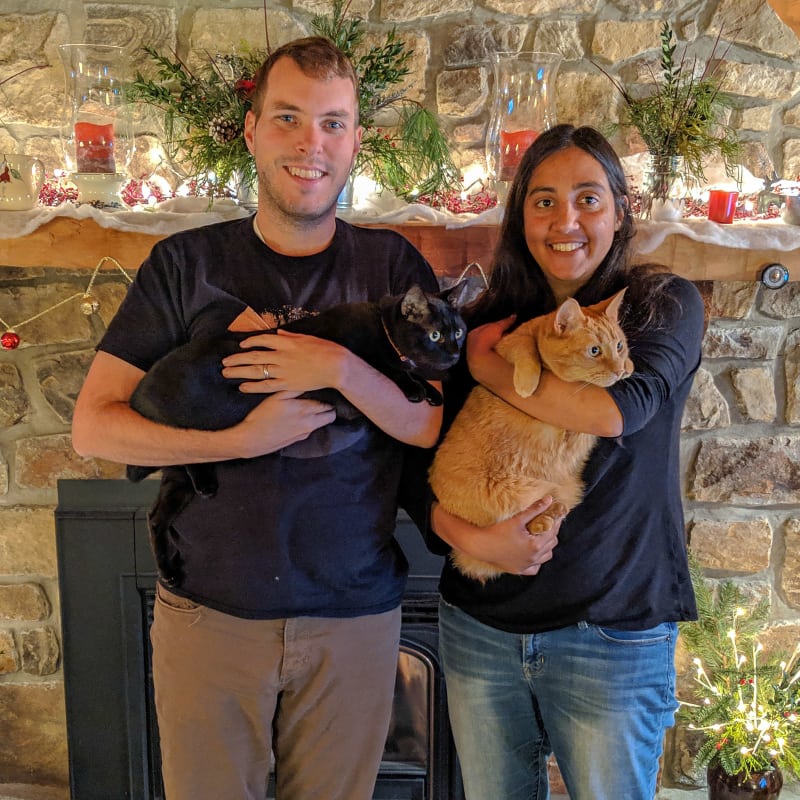
Our family!
I’ll start by giving you some stats on the first 6 months of our trip, and then go a little more in depth on how everything has gone so far.
Trip Statistics
States Visited
Distance Towing the RV
Distance Driven Total
Continental Divide Crossings
Highest Point Traveled
Curbs Jumped with the Trailer
Objects Backed Into with the Trailer
National Parks Visited
State Parks Visited
National Park Service Sites Visited
North American Deserts Visited
Great Lakes Visited
Longest single day of driving
Longest Stay in a Single Campground
Average Time Per Campground
Distance Hiked
Total Elevation Hiked
Instagram Posts
Blog Posts
Photos Taken
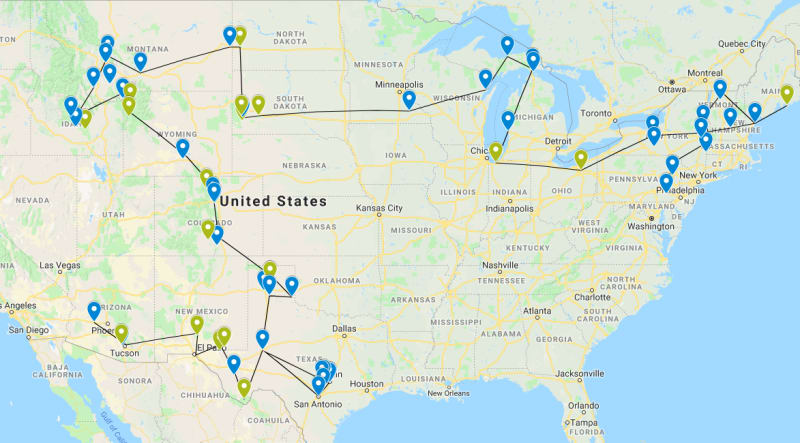
A map of our travels for the first six months
Our Favorite Stop
The first thing everyone asks is what our favorite stop on the trip has been, and it’s a question that’s almost impossible to answer. All of the places we’ve visited have been so vastly different. How do you compare a city to a desert? A mountain to a cave? A sand dune to a lake? That said, we’ll try to narrow it down a bit and give some favorites for different categories:
Favorite City
Austin, Texas
2nd place: Hailey, Idaho
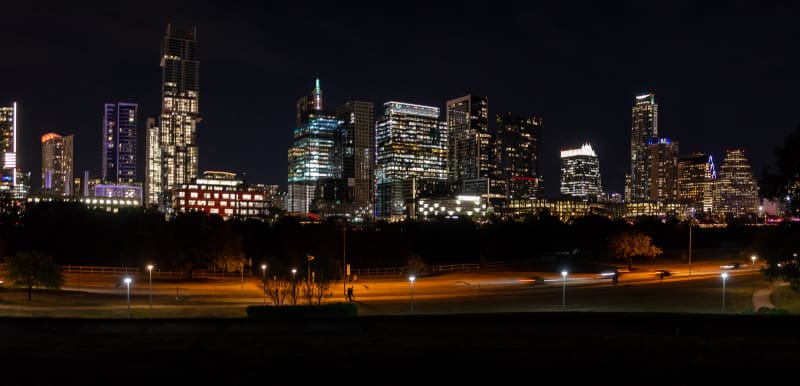
The skyline in Austin, Texas
Favorite Hike
Cascade Canyon, Grand Teton National Park
2nd place: Castle Trail, Badlands National Park
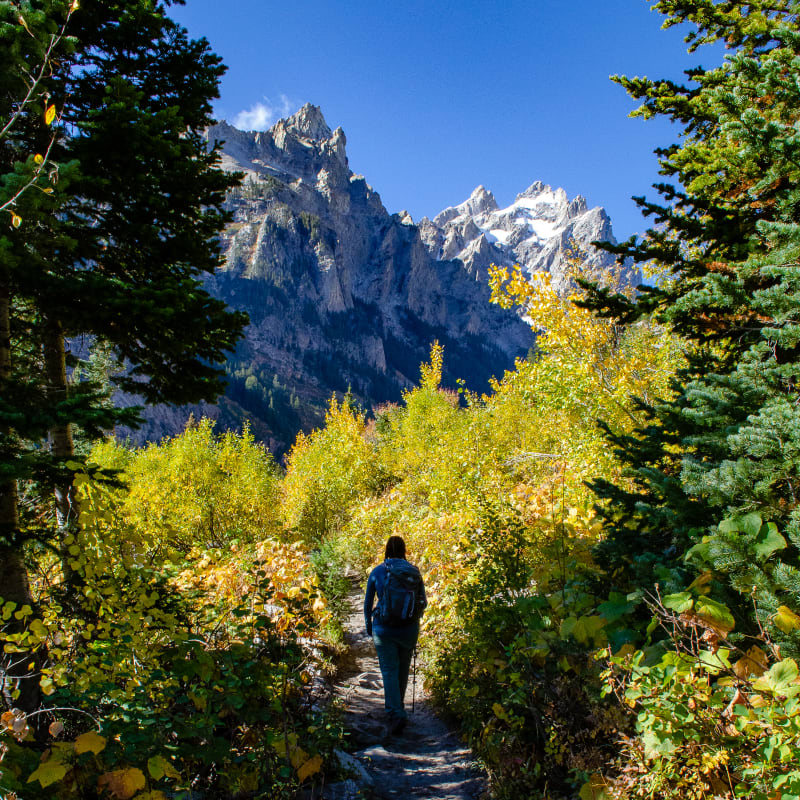
Hiking Cascade Canyon in Grand Teton National Park
Favorite Mountain View
Grand Teton National Park
2nd place: Sierra del Carmen, Big Bend
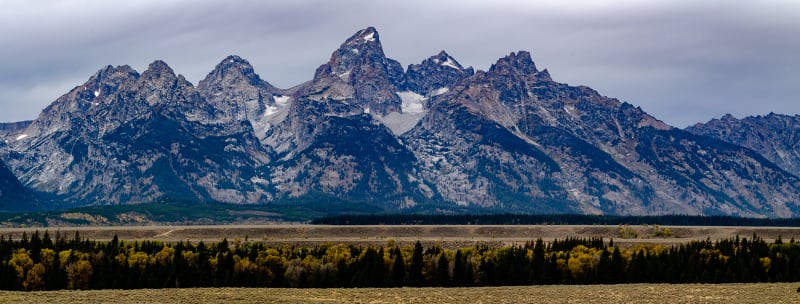
The Cathedral Group peaks of the Teton Range in Grand Teton National Park
Favorite Lake View
Jordan Pond from South Bubble Mountain, Acadia National Park
2nd place: Alturas Lake, Sawtooth National Recreation Area
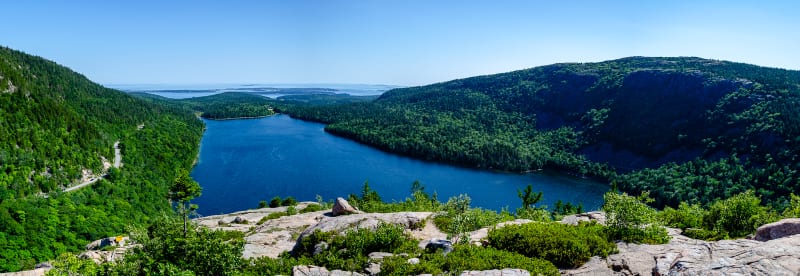
The view of Jordan Pond from the top of South Bubble Mountain in Acadia National Park
Favorite Camping Location
Nomad View Dispersed Camping, Badlands National Park, South Dakota
2nd place: Lower Teton View Dispersed Camping, Grand Teton National Park, Wyoming
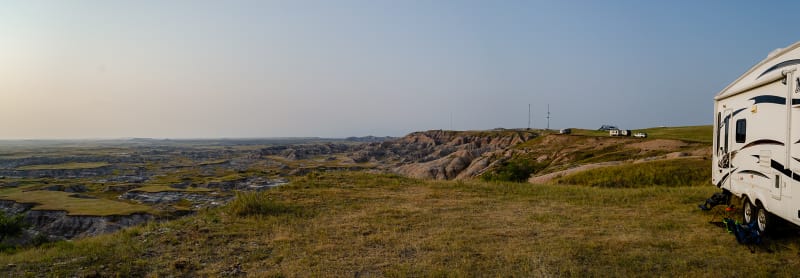
Nomad View Dispersed camping near Badlands National Park in South Dakota
Most Unexpectedly Cool Place
Big Bend National Park
2nd place: Carlsbad Caverns National Park
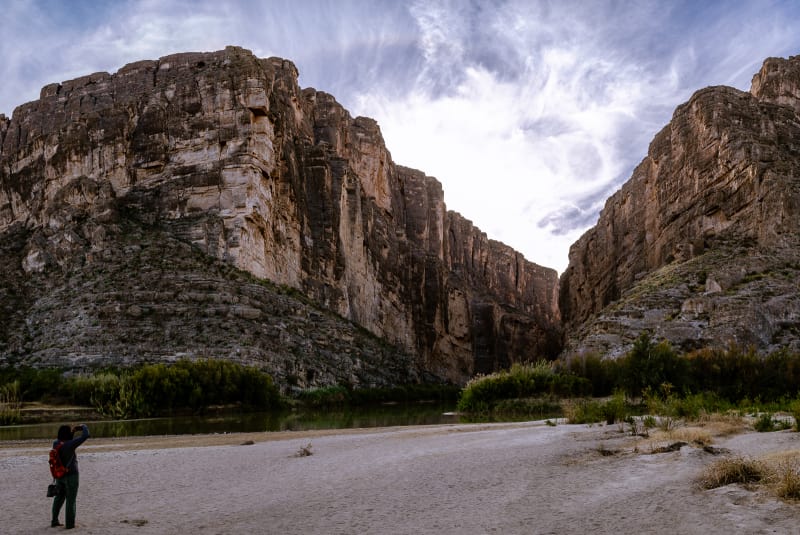
The entrance to Santa Elena Canyon in Big Bend National Park
Our Thoughts
The Good
Overall, the trip has been amazing! That’s probably not surprising. We’re incredibly fortunate to be able to travel around the country and see so many awesome things. It’s really hard to imagine doing that and having an overall negative experience. That said, there are a few things that stand out as particularly special and unique to the full-time travel experience.
One has been the opportunity to visit so many places we would not normally see. When you’re living on two weeks of vacation per year, you have to prioritize. Even places like Acadia National Park or Grand Teton National Park, two of the most popular national parks in the country, can be hard to visit. Places like Big Bend or Carlsbad Caverns, while still National Parks, are not as well known and off the beaten path. Somewhere like Sawtooth National Recreation Area or Pictured Rocks National Lakeshore? No chance. I didn’t know they existed before starting this trip, and it’s unlikely I would have discovered them. Even if I had, they are so far out of the way that I never would have gone.
But on a trip like this, you can find these places, and you can actually go. And there are so many examples like that. We’ve consistently found awesome things to see and do everywhere we’ve been. They’ve been experiences that there’s no chance we ever would have had otherwise.
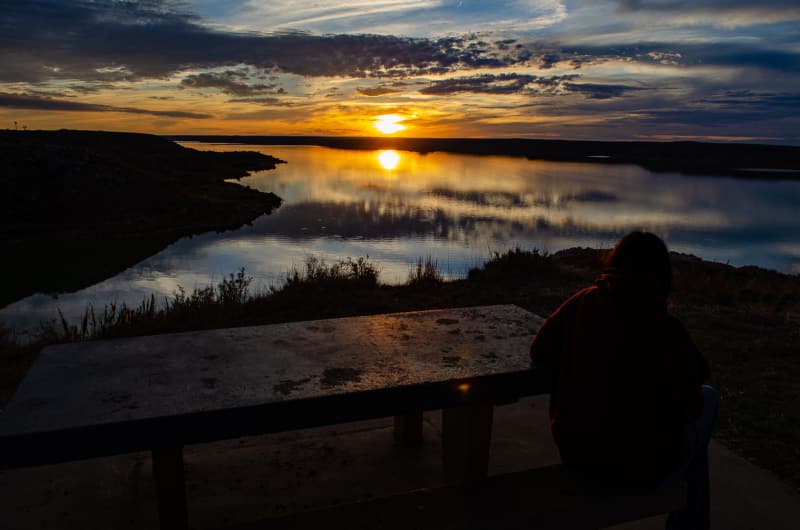
Sunset at Lake Meredith National Recreation Area
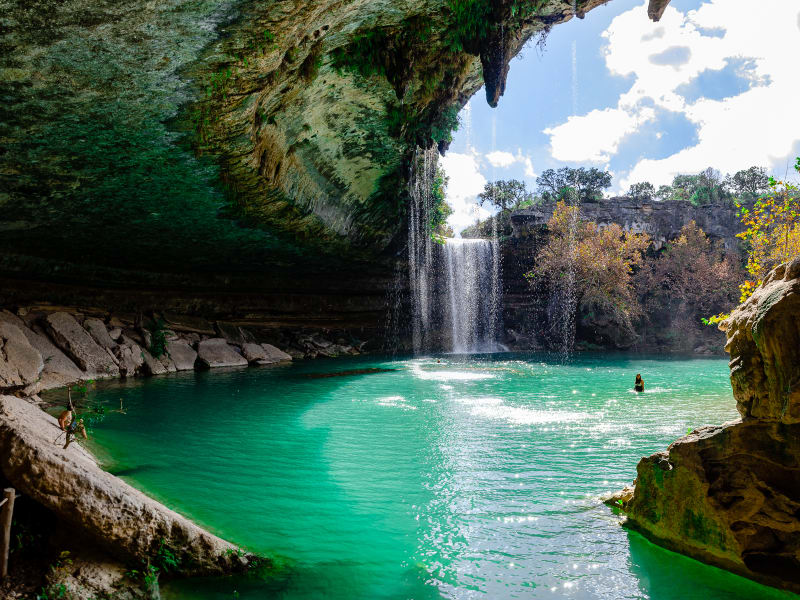
Swimming at Hamilton Pool Preserve in the Texas Hill Country
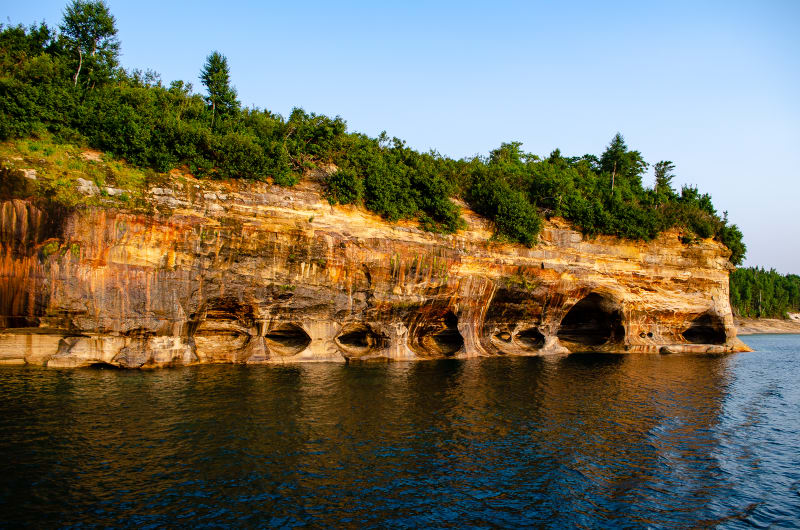
Pictured Rocks National Lakeshore
Another highlight of the trip has been the people we’ve met. I wasn’t quite sure how this would go when we started the trip, and it made me a little nervous. I think building a community on the road is an important part of keeping it sustainable. Campgrounds are filled with people, though, so I figured we’d find some there.
We did end up meeting a handful of people in campgrounds, but we ended up meeting people in many other ways, too. We attended RV meetups, large and small. We met fellow full-time travelers on park tours. We met one couple at an RV dump station. In Austin, we had an Uber driver who was preparing to go full time. The biggest surprise has been Instagram, though. I used it pretty sparingly prior to the trip, but we’ve found that it’s one of the best ways to connect and keep in touch with other travelers.
Regardless of how, we’ve met some really great people. We’ve explored cities, parks, and museums with them. We’ve hiked and had drinks around the campfire. We’ve cooked and played games. We’ve gone out to eat and danced. It’s really added something special to the trip. We’re looking forward to seeing many friends again this winter as we all descend on the southwest, and we’re looking forward to meeting many new ones.
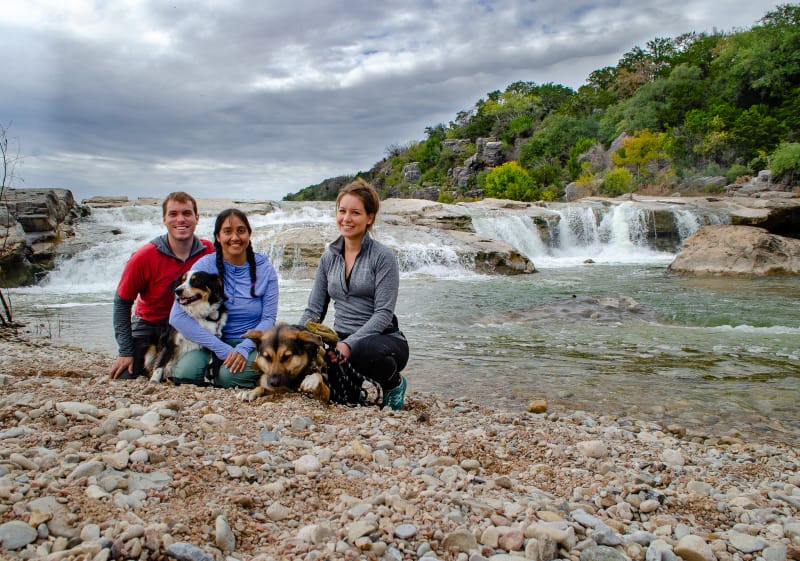
Exploring the Texas Hill Country with Cassie from Tails of Wanderlust
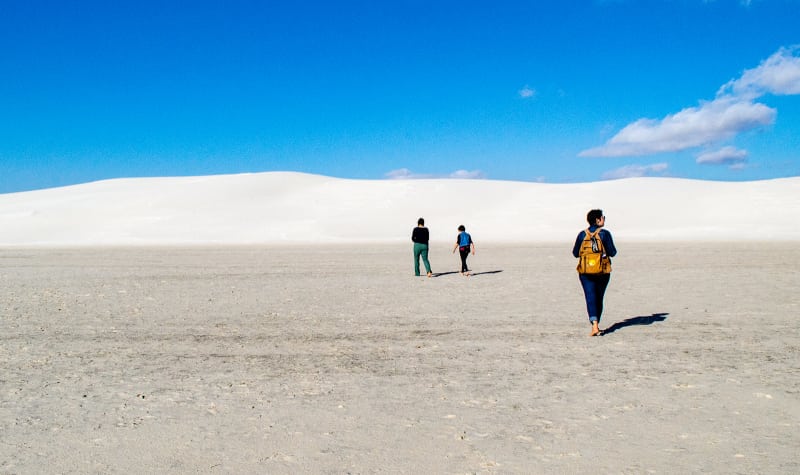
Enjoying White Sands National Monument with Meagan and Mollie of The Step Van Diaries
The Bad (ish)
Honestly, it’s a little hard to say there are any “bad” parts of the trip. If you’ve been following along on Instagram/Facebook, that’s probably not surprising. The vast majority of the time, though, I’m just posting the highlights of our stops. It’s not all beautiful hikes, national parks, and sunsets, though. Those things just tend to be more interesting than pictures of me cleaning the litter box. I’ll try to give a more rounded picture here, though.
Most of our days are pretty similar to those before we started the trip. We work. We cook. We clean. We do laundry. We go grocery shopping. Even when we’re visiting a national park or some other cool place, typically, at least half our time is spent on work and chores. There’s a lot of adulting to do, and unlike a vacation, we can’t put it off until we get home. We have to keep up with it, even when we’d rather go out and do one more cool hike.
The “bad” part is that all of those normal chores are now more difficult. We move quite often, and each time we do, we have to make sure we know where we can resupply. If we’re staying somewhere like Austin, Texas, then it’s pretty easy. If we’re somewhere like Guadalupe Mountains National Park, it’s quite a bit more complicated.
There, the nearest services were over 30 miles away, and the nearest reasonably sized town was almost twice that. We bought groceries at the stop before, but we had to find a propane refill along the drive. Nowhere close had cat food or flea meds, so we had to have them shipped General Delivery to the local post office. That post office was only open a few hours a day, so we had to plan our Carlsbad Caverns trip to coincide with picking up our packages. It’s not hard, but it takes a lot of planning and a lot more work than it used to.
Even meal planning takes a lot more work now since we don’t have a consistent schedule. We have to factor in where we’ll be and what we’re doing on any given week. If we’re somewhere like Big Bend National Park, and we know we’ll be away from the RV most days, then I plan a lot of meals that can easily be packed in a backpack. If we are boondocking for a week, I plan meals that don’t produce a lot of dirty dishes since water for cleaning is limited.
We’ve also struggled a bit with having limited internet. We do have 3 separate “unlimited” data plans (2 phones + a hotspot), but in reality, they are all capped and throttled after a certain amount of usage. We have about 45 gb of data per month pre-throttle, and we’ve used it all most months. This one was tough to judge ahead of time. We probably used 20x that per month living in an apartment, but I expected that we’d use far less on the road since we’d simply have less time and need. That’s partially true, but not completely. We definitely do use less, but we still find ourselves needing to wait for WiFi to download software updates or watch that youtube video about the thing we want to fix. It’s a hassle, and we’re planning to invest in a truly unlimited data plan soon.
The last challenge of the trip has been keeping up with maintenance. If you own a home, you’re probably already doing this. We had an apartment, though, so the only maintenance we had was occasionally changing a light bulb. Now, we have all of the normal maintenance things that come along with owning a home, except our home goes through an earthquake once or twice a week, so things wear out faster. We’ve been pretty fortunate and had no major problems. There have been plenty of small things, though. We had a cracked sewer pipe (thankfully on a gray tank). We have a shelf that likes to fall down. The drain on our fresh water tank started leaking. The fresh water inlet broke. Our door handle broke. The weather stripping on our basement doors does not want to stay in place. We just discovered that the seal around our hot water tank is wearing out. Again, nothing major, but we have to regularly inspect everything to try to catch problems early and fix them before they become more serious.
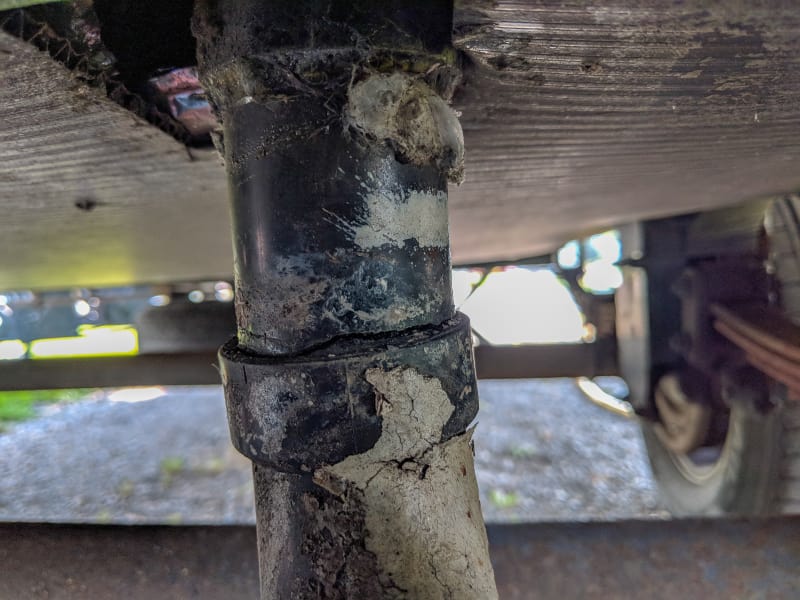
The sewer pipe for one of our gray tanks cracked and had to be resealed.
Lessons Learned
1. You have to prioritize
The first lesson we’ve learned is that it takes far more time than you’d expect to travel around the country. Prior to starting the trip, or really doing any route planning at all, we felt like a year would be tons of time. Six months in, it feels like no time at all. We often get suggestions for places to stop and see (which we love), but if we say we won’t have time to make those stops, people tend to be surprised. We’re traveling full time. How could we not have time? Thinking about it now, the problem isn’t so much that we don’t have time. We do. We’re just prioritizing other stops to fill that time. There are so, so many things to see and do, and just like traveling on two weeks of vacation per year, you still have to prioritize.
2. Fully experiencing an area takes a lot of time
Another similar lesson we’ve learned is that it takes far more time than you’d think to see everything an area has to offer. I don’t think there’s a single place we’ve visited where we left feeling like we saw everything there that we wanted to. Again, it ultimately comes down to prioritization. We could spend a month in one place, and that would probably be enough time to see it all, but then we’d have to completely miss a bunch of other places. So far, we’ve been prioritizing the highlights of each stop, and we’re hoping we’ll make it back in the future to see the rest.
3. Say, “Next time,” and be okay with it
We know that there’s a reasonable chance we’ll never return to many of the places we’re visiting. I hope that doesn’t end up being true, but it certainly could. With that in mind, there’s this feeling that you want to see as much as you possibly can while you’re there. It would not be hard to fill all day, every day with sight seeing. Even factoring in time for work and chores, though, you can’t spend all the rest of the available time on sight seeing. It’s just too much. We need down time.
At first, I would try to pack in as much as we possibly could. It becomes obvious pretty quickly, though, that it isn’t sustainable. We’d start planning days off, but I felt pretty bad every time we’d trade a day of sightseeing for a day of rest and relaxation in the RV. It can be stressful to think about how much you are missing out on. We’ve learned to reframe it, though, and focus on how much we’re still getting to see. Sure, there’s a lot more out there, but we had more time than many people ever do, and we can be thankful for that. Saying, “next time,” has become far easier now.
4. Slow down
It’s hard to really call this a lesson learned; we did a lot of research ahead of time, and almost every RVer comments about needing to slow down their travels. It’s not a vacation. You have to set realistic expectations. There are rules of thumb like traveling no more than 200 miles at a time or staying at least 2 days at each stop. It’s going to be different for everyone, though. Within the first two months, we already learned our starting pace was too fast.
In the first couple months, we moved, on average, every 3 days. That was too fast, and now our average is closer to every 4 days. As an average, that’s not too much of a change. What it doesn’t show, though, is that we’ve added longer stops in between the short ones. In the first two months, our longest two stays were 6 and 7 days. Since then, about once per month, we’ll stay in a single area for at least a couple weeks. In Texas, we said, “Next time,” to Padre Island and spent 23 days in Hill Country. We stayed in 3 different campgrounds, but the moves were all short and easy. In between the long stops, we’ll still move pretty quickly, but knowing we’ll have that break really reduces the stress. This pace feels like it is working pretty well for us, but we can always adjust again if needed.
5. Be Flexible
This one was tough for me. I like planning. I like knowing where we’re going to be and what we’re going to do. We’ve found that it ends up adding more stress than it’s worth, though. It also leads to missed opportunities. I think a key to full-time travel is being flexible.
One of the reasons we invested so much into our solar power setup was to be flexible in where we could comfortably stay. At the start of the trip, though, we’d still book sites at least a couple weeks in advance. As we traveled more, we booked less and less in advance. Now, we often stay at first-come, first-serve campgrounds, and even when we don’t, we rarely make a reservation more than a day or two in advance.
We have been lucky and never had any major issues when we booked sites ahead of time, but we’ve definitely seen the benefits of being more flexible. RVers often say they are following the weather. That’s typically in reference to seasonal changes, but it can also be true for daily weather. We originally planned to visit Padre Island while in Texas; however, as moving day approached, it looked like it would be windy and rainy most of the time we were there - not great beach weather. Rather than tough it out, we just stayed put and enjoyed nicer weather where we were. There was no stress at all in the decision even though we made it the day before we were set to go. We liked where we were and we stayed. No big deal. A few days before heading to Tucson, Arizona, we met a couple who had spent a lot of time in the area and strongly recommended Gilbert Ray Campground. It wasn’t one that popped up in my research of the area, but it ended up being an amazing spot (and also one where we got to camp with friends)! If we had already reserved a spot in the area, we never would have gone there, and we would have missed out.
This isn’t to say that we never make reservations. We booked our spot for the holidays since we had firm dates with our flights and knew where we needed to be. We’ll book Denali National Park very soon, even though the visit is over 6 months away, since we know where we want to be and it fills up early. We try to make those the exception, though. The rest of the time, we try to play it by ear and be open to new opportunities.
Ollie and Mango
Enough about us. How have the kitties been handling the trip? This is, after all, their adventure. Overall, they have adjusted really well to life on the road. The RV is their home, and they’re really comfortable in it. It is a bit less space than they had in New York City, but that hasn’t been a problem. They like to chase each other around, and there is still enough room for that, so all is good.
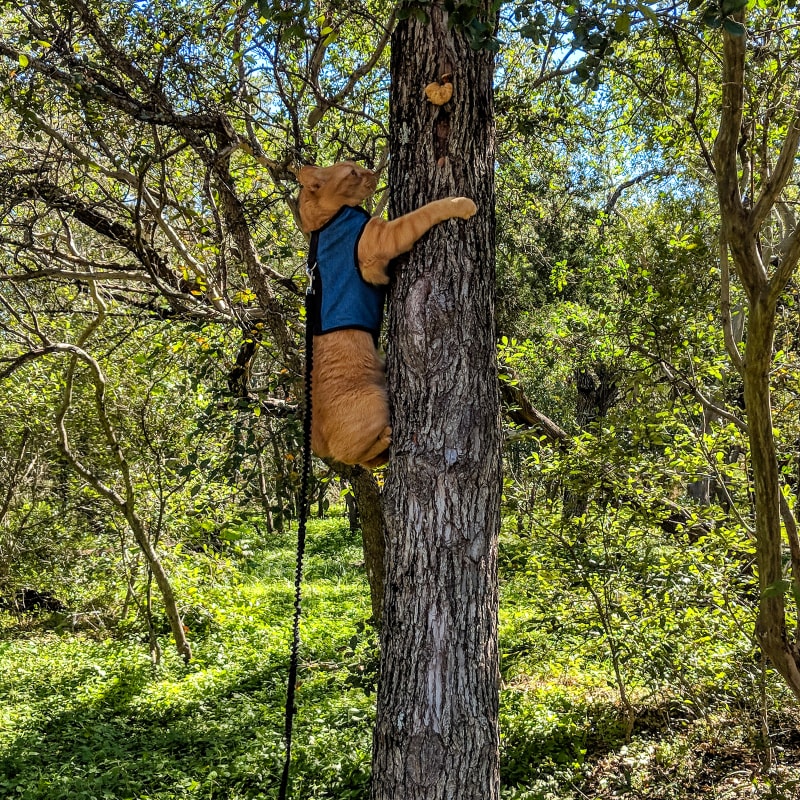
Mango adventuring in the trees
They’ve both adjusted really well to exploring outside and walking on a leash. Mango definitely adjusted faster. Within the first month, he was happily going outside, exploring new surroundings, and tasting all of the grass he could find. Ollie was slower to adjust. He was curious about going out, but he really didn’t like his harness. Over time, though, he has accepted it, and he will whine endlessly if we take Mango outside but not him. Ollie may even be the more adventurous of the two now.
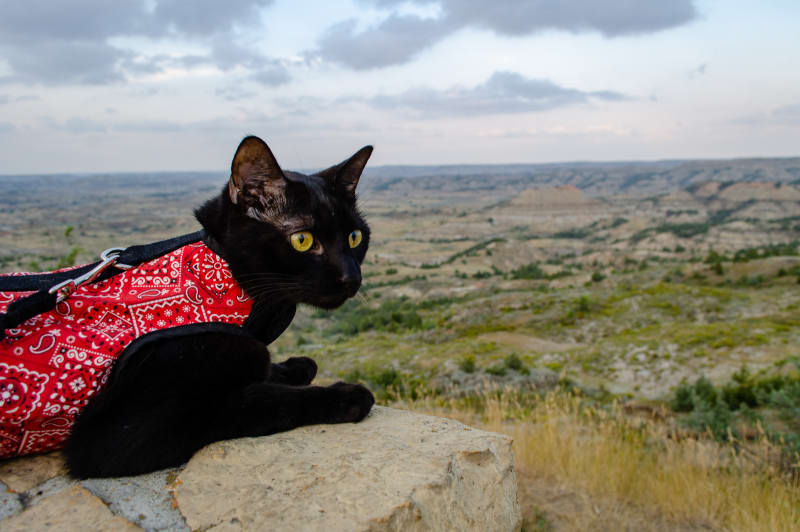
Ollie enjoys the view at Painted Canyon in Theodore Roosevelt National Park
Walking the cats still isn’t like walking a dog, but it’s getting closer. Most of the time, both will respond to a tug on the leash without simply falling to the ground. They won’t just walk along with you - there’s still a lot of stopping and waiting for them - but you can tug the leash and generally get them to go in the direction that you want.
We’re still working toward actually taking them hiking. Both do pretty well following a trail, but Mango especially will get startled easily when there are other people around, and once he’s scared, it’s hard to calm him down without taking him back to the RV. We’ll keep working on it, though.
The one thing the cats didn’t adapt well to is riding in their carriers in the truck. We bought nice (expensive) carriers that are crash tested and safe, but the cats hate being locked in them. We hoped they would adjust, but after two months of travel with them still whining the majority of the trip, we finally gave up and let them free in the truck. We figure the added stress of the carriers is probably negating any safety we’re gaining from the carriers. They still don’t like travel days, and they will hide when they see us start packing up the RV. Once we get them in the truck, though, they’re quite calm and mostly just sleep while we drive.
Mr. Trucky and LSP
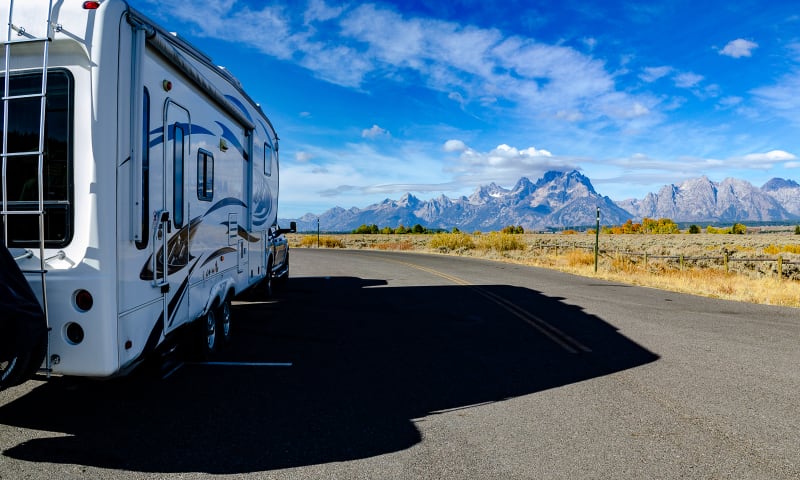
Mr. Trucky and LSP at Grand Teton National Park
Mr. Trucky and LSP have held up really well so far. Mr. Trucky has almost 20,000 more miles on him than when we purchased him, and aside from 4 oil changes, the only maintenance he’s needed is a ball joint replacement. Otherwise, he’s going strong! As mentioned above, LSP has needed minor maintenance, but luckily there haven’t been any major problems. The worst damage we’ve had is from the storm that hit us in South Dakota. We lost a slide topper, but everything else was cosmetic.
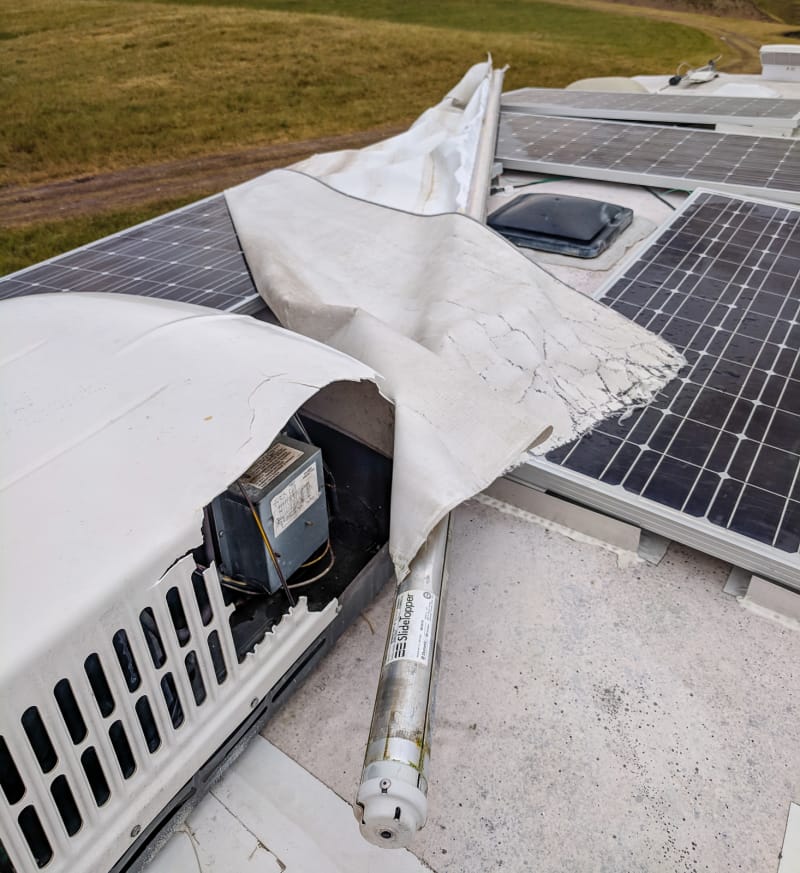
Damage to our slide topper and AC cover in South Dakota
We’ve also thought a lot about whether or not LSP ended up being the right RV for us. We put a lot of thought into this before purchasing it, but it’s hard to know what you’ll need until you’re actually living in it. In hindsight, it’s a bit larger than we really needed. We would have had enough living space in something smaller. The layout has been exactly what we needed, though. We’re also happy with the larger tank capacity and larger roof with space for plenty of solar power, both of which make boondocking more comfortable. Overall, it has worked really well for us.
When/Where will we stop?
People often ask where we think we’ll settle down when we stop. I really don’t know. We could still see ourselves moving back to New York City, but we could see ourselves ending up other places, too. The real truth, though, is that right now, it’s hard to imagine stopping at all. We’re loving the trip so far, and there are still so many things we want to see and do that aren’t going to fit into a schedule that ends next fall. Our original plan was to travel for approximately 1 year. We budgeted for one year, and we sketched out a route for one year. We’re already discussing ways to extend the trip, though.
With Sushila working part-time, we’ve been able to avoid spending any of our savings on month-to-month expenses. We could continue as-is for the foreseeable future, assuming we never planned to retire. We probably want to retire at some point, though, so we’ll need a bit more income. If we want to keep going, I’ll need to get a job again after the trip to Alaska. I’ll be looking for something that’s location independent, though. We’d slow down our travels, maybe moving once every two or three weeks, and continue traveling while maintaining more normal work schedules.
We’ll see how we feel in another 6 months, though. We aren’t limiting our options one way or the other. Ideally, we’ll keep traveling as long as we keep enjoying it. If the costs start outweighing the benefits, then we’ll settle down again. For now, we’re trying to stay flexible.
